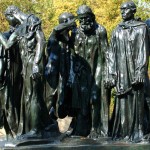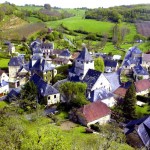In a previous post, I talked about two awesome TSR campaign settings that never got their own boxed set. 1) Jeff Grubb came up with a world of perpetual cloud where the forces of good had been pushed up to sunny mountain peaks, and cloud ships plied between the mountaintops. 2) Wayne Rossi has pointed out that the implied world of the OD&D books is actually not like any published setting, ever, and has reconstructed a bizarre and wild land of dinosaurs, cavemen, and flying Arthurian knights.
I propose that these two settings be combined, and that it all happen on the classic map from Wilderness Survival: Jeff Grubb’s “forces of good” live in the few hexes of mountain peaks, and the cloudy lowlands are overrun with OD&D Gygaxian weirdness.
These ideas together don’t constitute a full campaign setting. There are a lot of mysteries for us to solve. There were a lot of good suggestions in the comments last time; let’s tackle some new questions.
where do the clouds come from?
I have no idea. The only thing that I’m sure of is that the cloud layer rises a little higher every year, maybe as little as a foot. That gives the mountain peaks a nice doomed Atlantis feel. I like to think that the sages of some mountain peak, preparing for the worst, are building a Babel-like tower on the top of the highest mountain.
The adventurers may well be trying to halt or delay the advance of the clouds. In that case, the source of the clouds determines the kind of adventures the PCs will embark on. If we want to run a megadungeon campaign, the mists are rising up from some unknown source at the bottoms of the dungeons. If we want a mass combat campaign, then the mist is somehow generated by warlords in castles. Maybe the warlords have magic gates to a smoky dimension of fire mercenaries, or maybe the clouds are created by supernatural evil itself.
Or the source of the clouds could be a mystery, or an unexplained given in the campaign world. What do you think?
who lives outside the cities?
In this old post from Swords of Minaria, Evan notices that “The original world, tucked away and hidden in the white box, is one of fierce nomadic bands of humans and humanoids that scour the badlands.” Furthermore, based on the size of the Wilderness Survival map, he calculates that
By terrain type and encounter odds, this indicates the whole map contains an average of 44 large hordes of men and 41 small parties of heroes. Of the hordes, about 17 are bandits, 12 brigands, 7 nomads, 6 berserkers, 2 dervishes, 2 cavemen, 1 buccaneer and 1 group of river pirates. The heroic parties are equal numbers of fighting-men, clerics and magic-users with an average of 8 individuals per party. All told, this indicates there are 7,588 men roaming the countryside.
The wilderness is home to 7,500 human warriors! Whether the settled areas of the Wilderness Survival map are the towns (as in OD&D) or the mountain peaks (as in the Jeff Grubb-inspired setting), the civilized folks probably have far fewer soldiers than that.
It strikes me that, while OD&D presents the world as a battle between Law and Chaos, and Steve Winter mentioned good vs. evil in his cloud-world pitch, this setting is really about farming folk vs. nomads. In this case, the good/lawful guys are the farmers, and they’re losing. The PCs are armed, wandering war bands defending civilization – Seven Samurai fighting their own kind to protect farmers.
What’s up with all the nomads? Are they predominantly evil? Warlike but essentially neutral transhumant pastoralists, escorting their cattle from one grazing land to another? Noble barbarians? A mix? What kind of animals do they herd, and, in this world of dire and flying monsters, what do they ride?
What’s up with the bandits and brigands, two groups which form 2/3 of the wandering bands? Can their numbers possibly be supported by the smaller population of herders and farmers? How do they live? Or are they slowly starving? These questions are relevant for any OD&D White Box campaign, not just a White Box-sky pirates mashup.













